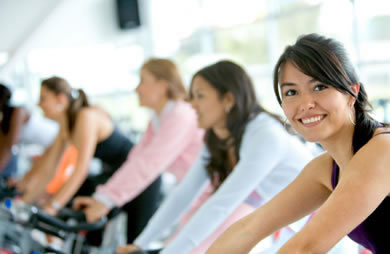|
For my students, breathing is the topic in yoga that prompts the most questions: How do you breathe in yoga? Should it be loud? How do I make that "noise" when I breathe? When the poses get too hard, I become out of breath. How can I keep breathing? Breathing is one of the most important elements--some would argue that it's the most important element--of a yoga practice, but for many of us, it is among the hardest to master. We focus on the stretch, the strength or the balance that is required to get into a pose, and we neglect the breath. I was guilty of that same attitude when I started practicing yoga. What did it matter if my breath was short or long, shallow or deep, through the nose or the mouth? As it turns out, it mattered greatly. If your breathing isn't relaxed, your body can't relax into the poses. If your body isn't relaxed, your mind can't relax. And if your mind isn't relaxed, you can't draw the full benefits from your yoga practice. Proper breathing and control, known as pranayama, is one of the eight "limbs" of the philosophy of yoga; asana, which is the physical practice most of us know as "yoga," is another of the limbs. Practically speaking, breathing slowly can lower your heart rate. It also brings fresh oxygen to the lungs, and in turn, the rest of the body. In yoga, we use a type of breath called ujjayi (ooh-JAH-ee), which means "victorious" in Sanskrit. To summarize, I tell my classes their breath should be slow, deep, and even. The breath is meant to simultaneously relax and energize the body. In flowing yoga classes, the breath sets the rhythm for the practice. Each movement is linked to a breath. Inhale, you move into pose, exhale you move out of it. The breath, I tell my students, is your metronome. In, out, in, out. The body matches the breath. Beyond that, the breath is drawn in and out through the nose, with inhalations and exhalations of equal length. The breath is drawn first into the lower belly, then the lower rib cage and finally the chest and throat. (Think: belly breathing rather than chest breathing.) The length and speed of the breath is determined by the diaphragm, and the breathing itself tones and strengthens that thin sheet of muscle beneath the lungs. When folded, twisted or stretched in a pose, the lungs have to work harder to fill up, which helps strengthen them. This becomes the challenge for new students. The throat is constricted slightly (more on that later), which produces that audible breath we associate with yoga. The mouth stays closed, and the tongue rests softly at the edge of the soft palate, where it meets the back of the top teeth. This placement is what naturally constricts the back of the throat, it prevents you from clenching your jaw, and it reminds you to keep your mouth closed. The sound of the ujjayi breath should be subtle, though it's different for everyone. When done properly, it sounds like the ocean. Chances are, you've encountered a zealous breather in a yoga class. You know the type. Their breath is so loud it sounds like they're exhuming a hairball or imitating a freight train. You've probably noticed that other people's breath isn't audible at all. In yoga, we steer clear of the words "ideal" and "perfect," and that includes the breath. Each person, each day, each practice is different. My own breath is rather quiet, even when I am at my most focused and relaxed during a yoga session. A few weeks ago, I took a class taught by my friend Doug, a yogi and musician. His "Rock Star yoga" begins with pranayama (breathing) techniques and stretches for the face, neck, throat and mouth. As we warmed up, Doug talked about the importance of breath, how it energizes the body. He said, "People always ask, 'Should the breath be loud?' I had a teacher who once said: 'If your breath is loud, it will quiet the mind. If your breath is quiet, it will quiet the body.' " So how can you start to bring more awareness to your breath? How can you start to link your movements and breath? Start with an easy breathing exercise. Sit comfortably in a chair or on the floor, eyes softly closed, tongue resting gently against the back of the top teeth. Inhale through the nose while counting silently to five. Pause for just a moment, then exhale for five counts. Try to keep the breath as even throughout; that is, don't exhale/inhale explosively at the start, only to run out of air/space in the lungs by the fourth count. Imagine you're sipping in air through a straw, which will keep the breath even and flowing. Repeat this exercise several times, until you feel like even inhalataions and exhlatiaons are less of an effort. Experiment with longer counts and shorter counts, and notice the effect that each has on your mind and body. What length feels "right" to you? OK, so slow, deep, even breathing is simple when you're not moving any other part of the body. What about keeping up the breath when you're moving the body? As a general rule, you inhale each time you move into a new pose; you exhale as you move out of one.  Let's use triangle pose (trikonasana, above) as an example:
The sun salutations (surya namaskara) are a great way to practice linking breath and movement. 
Experiment with the length of your breath. During one sun salute, silently count to five during each inhalation and exhalation. With the next couple of sun salutes, hold each breath a bit longer. Observe what happens to breath and movement when you slow down your breath. Are you moving more slowly, more mindfully? Now, try a couple of sun salutes with faster, shorter breaths. Though you might feel like you're getting more of a workout, how does the rest of you feel? Do you feel hurried? Stressed? Are you as focused as you were when you were breathing slowly. A couple of general rules about breathing:
Each person breathes as a different pace naturally, and it will take awhile for you to find a pace that's right for you. Be patient, continue your practice, and just keep breathing! This is the first in a series of blog posts about yoga basics. What topics would you like me to cover in the series? Do you have trouble keeping your breath and movement in sync during yoga? Thanks to my dear friend across the pond, Jen J, for inspiring me to write this post! 
|
Popular EntriesMore From SparkPeople
|

.jpg)



.png)















